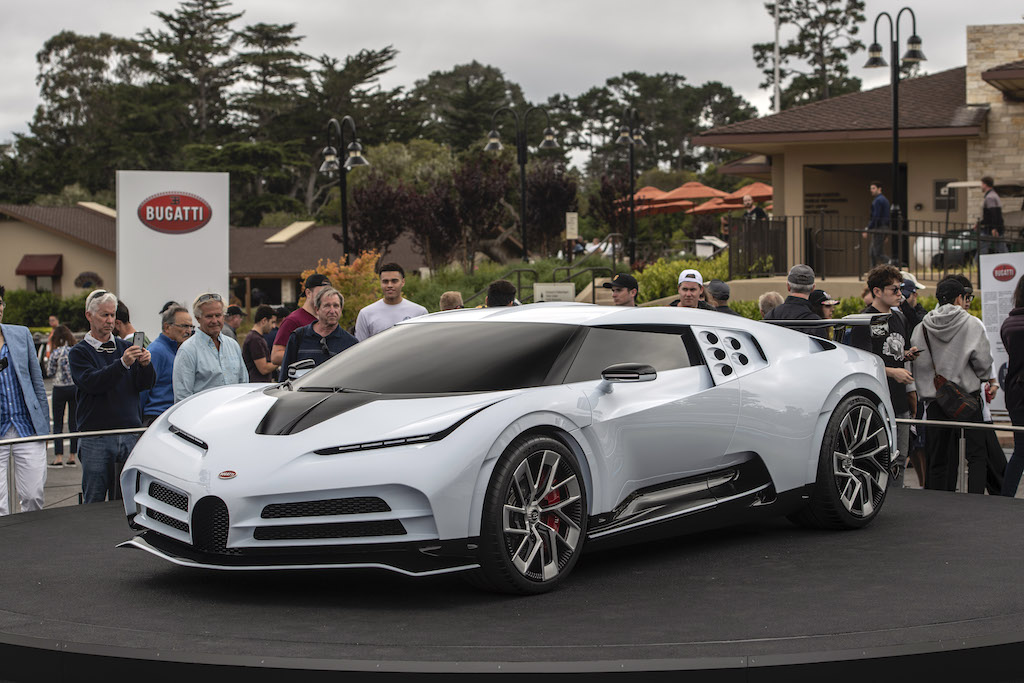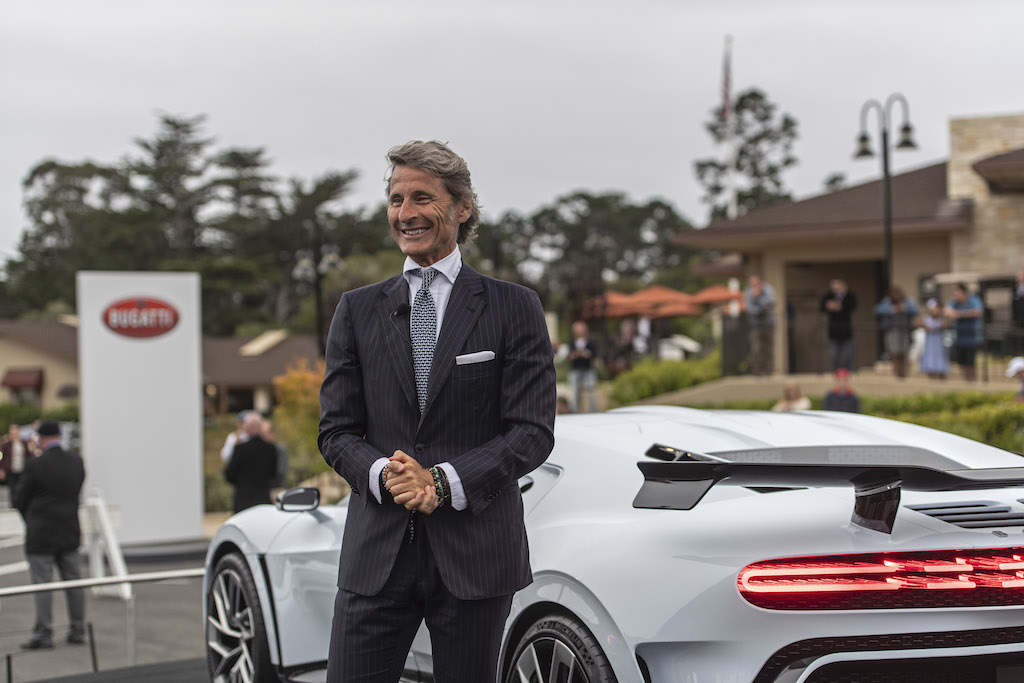Bugatti Centodieci

Bugatti Pebble Beach 2019
Ettore Bugatti was destined to build cars. First, his name had that certain je ne sais quoi and it looked great on a radiator badge. No disrespect to Ford, for example, but Bugatti really sounded much faster. And the fact that Ettore was an Italian who built his company in France gave the company a special cachet. Being from a family of artists was another plus so perhaps you could say that the Bugatti vehicles were preordained.
With a pedigree stretching back to the early 1900s, Bugatti was the brand to beat on the world’s tracks, especially in the 1920s. The company’s Type 35B won the first-ever Monaco Grand Prix (1929 – and eight of the sixteen cars in the race were Bugattis) and they won many other competitions of that era. Like most cars from that time, the brand was built on the back of racing accomplishments.
So it is no surprise that the modern-day Bugattis (a company owned by Volkswagen since 1998), all of which are named after the company’s famous drivers from the past, have impressive stats. The initial Veyron had 1,001 horses and the next iteration came forth with 1,250 of them. The Chiron weighed in with 1,500 ponies and now, the Centodieci — which was unveiled at “The Quail, A Motorsports Gathering” during August’s Monterey Peninsula / Pebble Beach Car Week – arrives with 1,600. (Rumor has it that, as of press time, the Chiron Super Sport will up the ante again – that seems quite likely since, as I write this, a “pre-production vehicle of a Bugatti Chiron derivative” beat the world record for production cars by besting 300MPH on a German test track.)

Bugatti Pebble Beach 2019
Centodieci, as fans of the romance languages can guess, means 110, which honors the company’s 110th anniversary. The day in August when it was announced, the company said that only ten of these cars would be made, that all ten had been sold, and that one buyer had bought two of them. As of that date, the announced base price was eight million euros (about $8,800,000 each). Must be nice.
So what’s so special about this car? First, let’s look at the design. Thanks to Achim Ancheidt, Bugatti’s Head Designer from the company’s modern-day resurrection, it has a design with roots from the past (way back to the EB110, the first Bugatti built after the company’s long hiatus – Ettore died in 1947 and the company ceased operations in 1952), before the VW Group bought the company. Yet the Centodieci benefits from Achim’s strong eye toward the future and his knowingness about how things function – he can sling a wrench as well as brandish a design pen, as evidenced by the 1920s Type 35 Bugatti that he is restoring himself, in his spare time.
Following the recent Centodieci unveiling, I had the distinct pleasure of talking with Achim for about an hour and, I must say, it was one of the most-enjoyable conversations I’ve ever had. He’s an engaging man who exudes the passion befitting the head designer of one of the world’s best-performing and most-storied car brands. He mentions his design muses as including his childhood fascination with cars and how the looks, sounds and even the fragrances were deeply imprinted on his impressionable mind. He truly lives and breathes Bugattis.

Bugatti Pebble Beach 2019
Before the Veyron and its successors, and before the VW era, Bugatti was resurrected in the early 1990s by an Italian entrepreneur Romano Artioli. His 1991 debut of the modern-day Bugatti was badged the EB110 as it was unveiled on the 110th anniversary of Etorre Bugatti’s birthday. It had a V12 motor and could top 220 MPH. To echo the design cues of the EB110 but to stuff it with a W16 motor presented (as Achim puts it so well) “complex aerothermal requirements”.
The Quail is known for a showcasing a surfeit of superb supercars on the lawn of Quail Lodge & Golf Club so walking around a small group of EB110s gave Achim the perfect opportunity to discuss and point out the design cues which he has incorporated in all of the Bugattis since he commenced designing them – super-clean lines, linear shapes and the like, clearly influenced by the minimalist Bauhaus-era designs of the first third of the 1900s. A rectangle here, a circle there, organized geometric designs comprising the vents and micro-ducts and other items which are the functional parts of the exterior. And due to the engine and gearbox both being rearward of the cabin, the passenger compartment could be folded inward, with sloping-in side glass and a swept-back windshield, to better envelop the occupants.
Ludwig Mies van der Rohe, the last director of the Bauhas school, is credited with the “less is more” saying (though it wasn’t he who created it but that’s another story). It’s hard to say the word “less” in conjunction with any modern Bugatti, given their prodigious power, but clearly the “form follows function” saying (credited to Louis Sullivan, an architect who was Frank Lloyd Wright’s early mentor) applies here. Simply put – if you want to shove a land-based vehicle through about 300MPH-worth of air and live to tell about it, it needs to be svelte enough to cut through the wind yet have enough downforce to keep the rubber side down. And in super-high-speed motoring, weight is the enemy.

Bugatti Pebble Beach 2019
Achim was tasked with designing the Veyron so that it would offer enough space for a W16 motor (and all the radiators and plumbing necessary to avoid self-immolation) in a package which reflected its ancestors’ genes, looked good and could hit the speed target (for the initial Veyron, it was 250MPH, which it beat). What he learned from the Veyron then was used for that model’s variants and then on the Chiron, the Divo and the La Voiture Noire and, most recently, the Centodieci.
The Buahus genetics and the form-follows-function mandate both are readily apparent in the gorgeous new model. For example, the interesting “flying taillights” are comprised of a multitude of red plastic rectangles, each seeming to float in 3D space, which provides both a visual treat to those behind the cars (which will be virtually everyone driving near one) and allows sufficient space between them for an exit route for the copious amount of heat flowing off of the massive powerplant. Of course, there’s the horseshoe grill, seen on virtually every Bugatti for over one hundred years, and Achim has incorporate the famous “Bugatti line” (which, when viewed on the driver’s side looks like a backwards letter “D” which often is painted a different color from the side panels and doors around it) in the air inlets on the sides, on the pillars just behind the doors. As you can see from the photos, it’s at once a revolutionary design which also is instantly recognizable as a Bugatti.
The Centodieci will be available in whatever colors the buyers choose but the unveiled model was a deep glossy white, which put it in great counterpoint to the luxurious shiny black of the La Voiture Noir, like “yin and yang”, said Stephan Winkelmann, President of Bugatti. With either of these models, you’ll get a tremendous car but my favorite is the Centodieci, the beauty of the show and certainly worthy of the company’s 110th anniversary.


Sorry, the comment form is closed at this time.